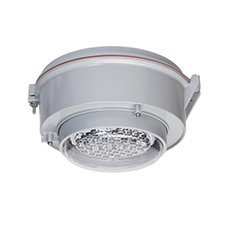
What Really Goes into Manufacturing Hazardous Location Fixtures
Chuck Ross
Most electricians and contractors are familiar with the concept of hazardous locations – areas where a fire or explosion could occur through the presence of flammable vapors or gases, combustible dust or easily ignitable fibers or flyings. This is important knowledge, because the National Electrical Code (NEC) has special requirements for equipment installed in these areas, including light fixtures. But these electrical pros might not all know how fixtures are designed to meet these rules, which basically boils down to keeping flames or hot gases from exiting a fixture and/or potentially flammable material from entering it.
As a quick reminder, the NEC’s hazardous location rules define requirements according to the dangers in the surrounding environment. Light fixtures installed in these areas must be designed to ensure they can meet the challenges any specific hazard could pose. Frank Cunningham, senior product marketing manager with Emerson, which makes the Appleton line of hazardous location luminaires, explains some of the ways manufacturers meet these varied demands, using fixtures developed for Class I, Division 1 Explosionproof and Class II, Division 1 Dust-ignition-proof locations as an example.
These luminaires, he says, are designed to prevent ignition from within the fixture to escape into the surrounding environment, so any kind of electrical arc or other flammable event can’t spark a wider fire or explosion. “The luminaires are designed with engineered flamepaths to vent the pressure of an explosion,” he says. These paths can be created by machining threaded connection joints specifically to serve this purpose. “The cooled gases are released from the flamepaths at temperatures that will not ignite the surrounding flammable environment.”
He notes that Class I, Division 2 and Class II Enclosed and Gasketed fixtures must meet the opposite challenge – keeping the surrounding hazardous atmosphere out. Cunningham says these fixtures are “sealed to prevent the hazardous atmosphere from entering the fixture’s interior. Contoured surfaces prevent accumulation of dust and reduce blanketing. Additionally, the internal components are engineered to radiate less heat.
As a quick reminder, the NEC’s hazardous location rules define requirements according to the dangers in the surrounding environment. Light fixtures installed in these areas must be designed to ensure they can meet the challenges any specific hazard could pose. Frank Cunningham, senior product marketing manager with Emerson, which makes the Appleton line of hazardous location luminaires, explains some of the ways manufacturers meet these varied demands, using fixtures developed for Class I, Division 1 Explosionproof and Class II, Division 1 Dust-ignition-proof locations as an example.
These luminaires, he says, are designed to prevent ignition from within the fixture to escape into the surrounding environment, so any kind of electrical arc or other flammable event can’t spark a wider fire or explosion. “The luminaires are designed with engineered flamepaths to vent the pressure of an explosion,” he says. These paths can be created by machining threaded connection joints specifically to serve this purpose. “The cooled gases are released from the flamepaths at temperatures that will not ignite the surrounding flammable environment.”
He notes that Class I, Division 2 and Class II Enclosed and Gasketed fixtures must meet the opposite challenge – keeping the surrounding hazardous atmosphere out. Cunningham says these fixtures are “sealed to prevent the hazardous atmosphere from entering the fixture’s interior. Contoured surfaces prevent accumulation of dust and reduce blanketing. Additionally, the internal components are engineered to radiate less heat.
Photo courtesy of Emerson Appleton



